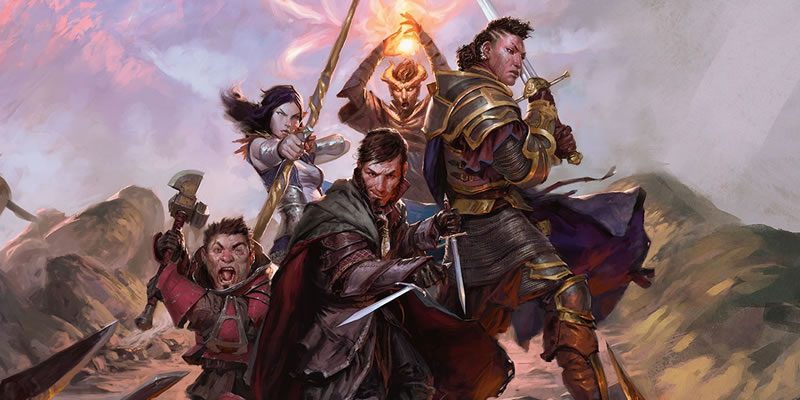Unearthed Arcana: Fiendish Options Breakdown

I don’t know about you, but my September 2017 felt like one of the longest months of my life – so it feels like it’s been ages since the last Unearthed Arcana came out. Today, however, we get a collection of content relating to fiends: new tiefling subraces, and cult boons for devils and demons. It’s a lot of content, so I’m diving right in.
Tiefling Subraces
Each of the Lords of the Nine gets their own tiefling subrace, which I think puts tieflings out in front for greatest number of distinct subraces. (Keep in mind that we got a proto-version of this in a previous UA, “That Old Black Magic.”) I love seeing radical variation for tieflings, because it’s probably the closest we’ll really get to the percentile tables of 2e Planescape tiefling generation.
First off, the Player’s Handbook tiefling is the Asmodean bloodline. So nothing new there. (There’s new Asmodeus-related content later in the document. Fear not. Actually, fear’s not a terrible idea. Go ahead and fear.) Just for ease of comparison, I’ll summarize here:
- +1 Int, +2 Cha
- Speed 30 ft
- 60-ft darkvision
- Resistance to fire damage
- Thaumaturgy, hellish rebuke at 3rd, darkness at 5th.
- The cantrip, first-level spell at 3rd level 1/day, and second-level spell at 5th level 1/day model is the through-line of the subraces, and I’m going to assume you understand my shorthand references.
Baalzebul’s tieflings gain the same modifiers, and instead of those spells, they gain thaumaturgy, ray of sickness, and crown of badness. (If you’ve been reading my articles here on Tribality for a little while now, you’ve seen me talk about crown of madness’s issues a lot. If you’re new, welcome! And follow that link.)
Dispater’s tieflings gain +2 Cha and +1 Dex, and thaumaturgy, disguise self, and invisibility. The intended theme is “spy and infiltrator,” though I’d suggest that with disguise self and invisibility in action, Dex is only barely necessary, and there would still be a great argument for Int (Investigation) or Wis (Perception/Insight). Anyway, these spells are ideal once-per-long-rest utilities. You’ll just about never have a day in which you’re not immediately glad to have invisibility on hand.
Fierna’s tieflings gain +2 Cha and +1 Wisdom, and friends (click here for another “why this spell doesn’t work” post), charm person, and suggestion. This is pretty well on-theme, so all they need is a better friends cantrip. Maybe just a guidance that is locked to Cha skill checks, which is – ahem – what crimfan suggested in the comments of last month’s UA Breakdown.
Glasya’s tieflings gain +2 Cha and +1 Dex, and minor illusion, disguise self, and invisibility. The intended theme is “Hell has its own take on organized crime,” but the close similarity between this and Dispater’s brood suggests that they could use more distinguishing elements.
Levistus’s tieflings gain +2 Cha and +1 Con, and ray of frost (interesting, in that this could be a playstyle-defining feature for certain characters), armor of Agathys, and darkness. All around, pretty solid – though without a Devil’s Sight feature, darkness is much more of a niche application.
Mammon’s tieflings gain +2 Cha and +1 Int, and mage hand, Tenser’s floating disk (once per short or long rest, rather than just long) and arcane lock. That’s solidly on theme for gathering, transporting, and guarding wealth, though arcane lock is one of those things that I just don’t see PCs need more than once in a very long while. I’m dubious that this subrace will see much use of its features in actual play.
Mephistopheles’s tieflings gain +2 Cha and +1 Int, and mage hand, magic missile, and web. That looks like an expression of “all about arcane magic” to me. Also, you’ll probably use magic missile and web just about every day. Looks good.
Zariel’s tieflings gain +2 Cha and +1 Str, and thaumaturgy, searing smite, and branding smite. All things considered, I’m not clear on why Zariel has tiefling spawn rather than fallen aasimar. On the other hand, the spells are overtly paladin-like. Maybe it’s Bel’s fault somehow, since the trait makes it a little more about Avernus than about Zariel personally?
Diabolical Cults
There are also nine listings for infernal cults, made up of the cult’s goals, the stereotypical members of the cult (listed as MM stat blocks, interestingly), signature spells of the cult (which will naturally shape the spellcasters’ tactics), one trait that you can add to any cult member, and one trait that is just for leaders of cults. Many of the leader features are brutally selfish, about like you’d expect.
The cult of Asmodeus doesn’t have the full run of features, though – it’s treated as a meta-cult that a really top-flight leader of any other cult might also join. The Demands of Nessus feature keeps that cult leader alive at the cost of their less-important, less-favored allies. It looks pretty on-message to me, though it’s only enough hit points to lightly tap the brakes on incoming damage, not keep up with it (unless the PCs are spreading their attacks all over the place).
I’m surprised to see that the cult of Baalzebul’s signature (illusion) spells have nothing in common with the Legacy of Maladomini racial trait. The theme expressed for Baalzebul in relation to tieflings and in relation to the cult can work together, but superficially they don’t seem to have anything in common. Neither of those themes quite with what’s in the DMG, though the cult description is at least closer to the DMG version. Having said all that, all three are individually fine – they’re just a mess when it comes to establishing canon. The cultist trait steals luck from an ally, by imposing disadvantage on all of the ally’s rolls in exchange for gaining advantage on one’s own rolls.
The cult of Dispater’s signature spells are at least clustered around information gathering, if not around personal buffs for spies. The themes expressed for the cult and for Dispater’s tieflings match up well. It’s not quite the same as what’s in the DMG, but it’s not too far off it either. The general cult trait, Infernal Insight, is a bit of a stretch. It assumes that the knowledge that Dispater has gathered can be applied to absolutely any situation, so… sure I guess. The cult leader trait, Vexing Escape, seems more out of place – damage prevention and a teleport are handy but it’s a stretch to connect them to Dispater.
In contrast to the above, the cult of Fierna’s signature spells are exactly the spells granted to tieflings, with the addition of hypnotic pattern at 3rd level. (It’s also strange that this document emphasizes Fierna over Belial, rather than going for equal time. Fake news, y’all.) The theme expressed here is in line with the tiefling theme, but the DMG says less about Fierna than other archdevils, because it needs to spend some of its tiny word-budget on Belial. Fierna’s cult trait and cult leader trait work closely together, and they present beneficial leadership rather than selfishness.
It’s interesting that there is a cult of Geryon, since he doesn’t appear as a tiefling progenitor and the DMG describes him as languishing in disgrace in Stygia. Thus there’s no point of comparison in a tiefling racial feature, and the cult definitely doesn’t resemble the Legacy of Stygia feature. The signature spells and the features for cultists and leader work fine for the brute-warrior description that Geryon receives.
Glasya’s cult takes a slightly different tack with its organized-crime theme than the tiefling subrace writeup suggests, but it’s close enough for government work. The signature spell list shares some spells with the tieflings, while charm person and haste are new. The cultist trait is a short-term invisibility, similar to the Trickery Domain’s Cloak of Shadows… except that it isn’t broken by attacking or casting a spell. The cult leader trait is good for helping your bodyguards guard your body, which is nice to have as a crime boss. I pretty much like what this cult has going on.
Ah, okay, Levistus doesn’t have a cult, strictly speaking, just a few people desperate enough to reach out for his help. That fits pretty well. There are still signature spells, which are standard panic-button options (blade ward, expeditious retreat, spider climb, and gaseous form). The cultist boon is a once-ever get-out-of-jail-but-definitely-not-free card. The paragraph describing that bargain is a bit garbled with repetition, but that’s okay. The point is, I know what Levistus is about and it makes a lot of sense that the cult writeup doesn’t connect to the tiefling racial features.
The designers have a lot less freedom to define Mammon’s theme than other archdevils – it’s a name that means greed. The signature spells resemble those given to tieflings (sharing two out of four), while the cultist trait is a short-range-teleportation pickpocketing. Great for starting up a chase scene, if the cultist can steal something and make a run for it. The cult leader feature basically makes the leader’s allies gang up on someone and curb-stomp them for their lunch money. I get what they’re doing here, and I think it works well.
The cult of Mephistopheles is likewise adhering to real-world tradition, so there’s no daylight between the cult’s theme and the tiefling subrace writeup. The spells are very different, but if anyone is going to demonstrate a breadth of spells, the Original Conjuring Cat is the one. The Spell Shield cultist feature is even a strong argument that the greatest magicians have something to learn from him. The cult leader feature is sort of a waste of time for spellcasters other than sorcerers (cheap-as-free sorcery points) and warlocks, but it is fucking phenomenal if you and your cult all use Pact Magic for your spellcasting.
The cult of Zariel is more like an order of fallen paladins – a fair gloss on the Knights of Takhisis, if you ignore the mechanics side of that canon. Anyway, the spells are very different from the tiefling subrace feature, but they’re still on-theme for warrior cultists. Here’s a free plot seed for you: ask yourself if that knight you just met who is casting crusader’s mantle and beating the snot out of demons with you is a paladin or a Zariel cultist. Next, wonder if you care. The cultist feature is amazing (convert a hit to a crit, 1/short rest? With smite spells on the line? Let’s do this). The cult leader feature relies on NPCs having separate initiative rolls, which means this feature plays very poorly with most common initiative systems. Still, fix that one up, and the cult of Zariel is a great Honorable Opposition figure.
Demonic Boons
These are presented less as organizations and more as gifts that individuals receive. There’s a much greater emphasis on boosting (or cutting) ability scores, which the Diabolical Boons text only hints at. There are eight demon lords spelled out here – the ones you’d expect if you read the DMG (but sans Lloth) or Out of the Abyss.
Baphomet’s cult is about hunting down asses to kick, with great force. It grants ability score bonuses that make sense to that, its features touch on the connection to minotaurs, and the cultist and cult leader features are great. Done right, the cultist feature sells everything you need for a slasher film, but if that isn’t enough, have slow as a signature spell. This cult is great, top to bottom.
Demogorgon gives his solitary cultists a mixed bag of spells – all useful for carrying off a murder, but sort of going in different directions tactically – charm person, enlarge/reduce, and vampiric touch are all great, but I think most NPCs will have a hard time using charm person to isolate and murder a PC. (On the other hand, using it to isolate and murder NPCs that the PCs care about is spot on, and I probably don’t need to tell you that if you’re running horror, kill their friends first is just good practice.) The Strength and Charisma boosts help sell the charming-sociopath angle, and the Two Minds of Madness feature doesn’t hurt either.
Fraz-Urb’luu’s cultists are set up to be illusionists, with a spell list strongly reminiscent of Glasya’s tiefling brood. The Wisdom and/or Charisma boosts are nice (and… I guess these bonuses can break the cap of 20 on ability scores, because it doesn’t specify otherwise and it would be lame if you were too awesome for a demon lord to bother tempting you), but Liar’s Eye is amazing. Spend a bonus action to detect all illusions and all hidden creatures in 15 feet? Niiiice.
Graz’zt is my favorite (by far and away) of all the demon lords, a decision in which I am strongly biased by Sepulchrave’s Tales of Wyre story hour over in ENWorld. He’s a little more Slaanesh than the story hour led me to believe, but Slaanesh is awesome too. Anyway, Graz’zt’s cult is into some real freaky shit and their signature spells reflect that nicely. The cultist and cult leader features take that a lot further. Of the demon lords up to this point in the list, only Baphomet’s cult gives this one a run for its money on apparent threat.
Jubilex is a demon lord I’ve always had a hard time caring about, even if I am assured that there is always room for Jubilex. She’s a great example of how the Abyss sometimes favors maximum weirdness over actionable goals or ambition. Her ability score boost to Constitution runs up to a staggering +8, but it must be mirrored by an equal penalty to Int, Wis, and Cha. Other demons want to screw with you – Jubilex thinks your humanity (or whatever recognizable race) is the first thing to go. She has no signature spells, but her cultist and cult leader traits are flashy and potent. One note – I’d suggest that “resistance against nonmagical B/P/S damage” doesn’t stay useful very late into most campaigns. More so in my own, for some characters. The acidic explosion portion of Slimy Organs is amazing and I love it.
Orcus combines everything you love about demon cults with everything you love about necromancy cults. He boosts Int or Wis, which is about right, and his signature spells are a good spread of necromancy spells. Undying Soul is great for potentially keeping villains alive after escapes that “no one could have possibly survived.” Aura of Death offers three distinct elements to the cult leader and their allies – immunity to fear (well, okay, you can break it for the whole group by killing the leader, so… fair), resistance to radiant damage (this would be more on-point if there were a few more undead-specific nukes that were radiant damage), and it imposes disadvantage on enemy death saves. I think this feature could use a rework, but otherwise this cult does what it came to do. (Definitely not in Mechanus, no sir.)
Yeenoghu’s cult does technically include creatures that are not gnolls, but gnollishness rubs off on them over time. Interesting to realize that in D&D, the backwoods-cannibal trope should be Yeenoghu cultists. Note to self… Anyway, they gain bonuses to Strength and/or Dex and a matching penalty to Int and Cha. Slavering psychopath is not a good look for anyone. The signature spells are pure crowd-control, and overly repetitive as a result. Cultists gain two features – a bite attack and a Cleave-like extra bite with a move when you drop a creature. The cult leader feature powers this up further. All in all, good, but probably going to be playing second fiddle to Baphomet the whole time.
Zuggtmoy runs in the direction of Jubilex, freeing her followers from their burdensome higher brain functions. In return, they get one of the more underwhelming ability score adjustments and the Spore Kissed trait. If you play your cards right, you could set off a chain reaction of exploding mushroom cultists, or you could get caught in it. That’s a lot of possible poison damage, if you use these as zombie-like shambling mushroom people. If I have a complaint about this, I’d say that it’s too close to just-another-Jubilex, but the larger radius on Spore Kissed’s explosion probably matters disproportionately.
There are also suggestions of rules for cults surrounding demons of less than “lord” status, and we need to talk about the fact that the Marilith feature – Serpentine Reaction – is as good as a Legendary Action, in the right hands. (Here “the right hands” is “someone with Sneak Attack dice and one or more really good reaction triggers.”) I like that these are here, but they are really not all created equal. But Mearls and Crawford present the cults as DM-facing content to modify NPCs, not a stealth announcement that they have grabbed the Stormbringer license. Which is, let’s be honest, the most ideal use of this content.
Conclusion
Overall, this is one of my favorite Unearthed Arcana articles that they have ever released. As a DM, the use-it-today! potential of this article can’t be beat. It’s also eight pages of steady adventure inspiration. The difference in format and presentation between diabolical and demonic cults makes me wonder if they split the subject matter after discussing in general how it would look, but not comparing notes once it was done. It’s no deal-breaker, but it does look weird on the page.



